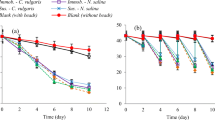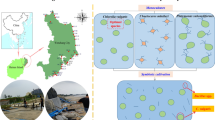Abstract
The accumulation of nitrogen and phosphorous has detrimental effects on aquatic animals and negatively influences the economic benefits of aquaculture; thus, the control of water quality is of significance for the development of the aquaculture industry. In this study, a coculture system of Chlorella vulgaris + Rhodosporidium sphaerocarpum exhibited superior nitrogen removal performances compared with those of either the Isochrysis galbana + R. sphaerocarpum or the Tetraselmis helgolandica + R. sphaerocarpum coculture systems. The alginate-immobilized C. vulgaris and suspended R. sphaerocarpum coculture system was advantageous in terms of nutrient removal and the inoculum ratio (IR, dry weight of C. vulgaris to dry weight of R. sphaerocarpum) of 5:1 was determined to yield optimal removal performances of nutrients and the chemical oxygen demand (COD), with which 86.20% of the NH4+ content was removed, and 100.00% removal efficiency of NO2−, NO3−, PO43−, and COD was detected after 120 h of incubation. The growth of C. vulgaris and R. sphaerocarpum was enhanced and a biomass productivity of 0.22 g L−1 day−1 was obtained. The sustainability of the optimized microalgae-yeast coculture system was confirmed by steady and consistent removal performances in semicontinuous experiments, removing over 80% of NH4+, 100% of NO3−, and over 90% of NO2−, PO43−, and COD. These results indicated that the optimized microalgae-yeast coculture system developed in our studies might provide a potential method for the biological treatment of aquaculture wastewater.






Similar content being viewed by others
References
Alcaraz G, Chiappa-Carrara X, Espinoza V, Vanegas C (1999) Acute toxicity of ammonia and nitrite to white shrimp Penaeus setiferus postlarvae. J World Aquacult Soc 30:90–97
Amar EC, Kiron V, Satoh S, Watanabe T (2004) Enhancement of innate immunity in rainbow trout (Oncorhynchus mykiss Walbaum) associated with dietary intake of carotenoids from natural products. Fish Shellfish Immunol 16:527–537
Ansari FA, Singh P, Guldhe A, Bux F (2017) Microalgal cultivation using aquaculture wastewater: integrated biomass generation and nutrient remediation. Algal Res 21:169–177
Banerjee S, Tiwade PB, Sambhav K, Banerjee C, Bhaumik SK (2019) Effect of alginate concentration in wastewater nutrient removal using alginate-immobilized microalgae beads: uptake kinetics and adsorption studies. Biochem Eng J 149:107241
Bjerkeng B, Peisker M, von Schwartzenberg K, Ytrestoyl T, Asgard T (2007) Digestibility and muscle retention of astaxanthin in Atlantic salmon, Salmo salar, fed diets with the red yeast Phaffia rhodozyma in comparison with synthetic formulated astaxanthin. Aquaculture 269:476–489
Cheirsilp B, Suwannarat W, Niyomdecha R (2011) Mixed culture of oleaginous yeast Rhodotorula glutinis and microalga Chlorella vulgaris for lipid production from industrial wastes and its use as biodiesel feedstock. Nat Biotechnol 28:362–368
Chien YH, Pan CH, Hunter B (2003) The resistance to physical stresses by Penaeus monodon juveniles fed diets supplemented with astaxanthin. Aquaculture 216:177–191
Chun SJ, Cui Y, Ahn CY, Oh HM (2018) Improving water quality using settleable microalga Ettlia sp. and the bacterial community in freshwater recirculating aquaculture system of Danio rerio. Water Res 135:112–121
Cruz I, Yoav B, Gustavo HC, Luz E (2013) Biological deterioration of alginate beads containing immobilized microalgae and bacteria during tertiary wastewater treatment. Appl Microbiol Biotechnol 97:9847–9858
de Alva MS, Pabello VML, Ledesma MTO, Gomez MJC (2018) Carbon, nitrogen, and phosphorus removal, and lipid production by three saline microalgae grown in synthetic wastewater irradiated with different photon fluxes. Algal Res 34:97–103
Ebeling JM, Timmons MB, Bisogni JJ (2006) Engineering analysis of the stoichiometry of photoautotrophic, autotrophic, and heterotrophic removal of ammonia–nitrogen in aquaculture systems. Aquaculture 257:346–358
FAO (2018) The State of World Fisheries and Aquaculture 2018 - Meeting the sustainable development goals. FAO, Rome
Hao XD, Wang CC, Lan L, van Loosdrecht MCM (2008) Struvite formation, analytical methods and effects of pH and Ca2+. Water Sci Technol 58:1687–1692
Hargreaves JA (2006) Photosynthetic suspended-growth systems in aquaculture. Aquacult Eng 34:344–363
Hemalatha M, Sravan JS, Min B, Mohan SV (2019) Microalgae-biorefinery with cascading resource recovery design associated to dairy wastewater treatment. Bioresour Technol 284:424–429
Ji MK, Kim HC, Sapireddy VR, Yun HS, Abou-Shanab RAI, Choi J, Lee W, Timmes TC, Jeon BH (2013) Simultaneous nutrient removal and lipid production from pretreated piggery wastewater by Chlorella vulgaris YSW-04. Appl Microbiol Biotechnol 97:2701–2710
Lau PS, Tam NFY, Wong YS (1997) Wastewater nutrients (N and P) removal by carrageenan and alginate immobilized Chlorella vulgaris. Environ Technol 18:945–951
Li HK, Zhong YM, Lu Q, Zhang X, Wang Q, Liu HF, Diao ZH, Yao C, Liu H (2019) Co-cultivation of Rhodotorula glutinis and Chlorella pyrenoidosa to improve nutrient removal and protein content by their synergistic relationship. RSC Adv 9:14331–14342
Liu K, Li J, Qiao HJ, Lin A, Wang GC (2012) Immobilization of Chlorella sorokiniana GXNN 01 in alginate for removal of N and P from synthetic wastewater. Bioresour Technol 114:26–32
Liu PP, Qiu LP, Zhang SB, Wang JB, Xie K (2016) Recent development of scale marine aquaculture wastewater treatment. In: Proceedings of the 2015 4th International Conference on Sustainable Energy and Environmental Engineering, vol 53. Atlantis Press, Paris, pp 496–499
Liu H, Lu Q, Wang Q, Liu W, Wei Q, Ren H, Ming C, Min M, Chen P, Ruan R (2017) Isolation of a bacterial strain, Acinetobacter sp. from centrate wastewater and study of its cooperation with algae in nutrients removal. Bioresour Technol 235:59–69
Maldonade IR, Rodriguez-Amaya DB, Scamparini ARP (2008) Carotenoids of yeasts isolated from the Brazilian ecosystem. Food Chem 107:145–150
Malibari R, Sayegh F, Elazzazy AM, Baeshen MN, Dourou M, Aggelis G (2018) Reuse of shrimp farm wastewater as growth medium for marine microalgae isolated from Red Sea - Jeddah. J Clean Prod 198:160–169
McLean E, Barrows FT, Craig SR, Alfrey K, Tran L (2020) Complete replacement of fishmeal by soybean and poultry meals in Pacific whiteleg shrimp feeds: growth and tolerance to EMS/AHPND and WSSV challenge. Aquaculture 527:735383
Mennaa FZ, Arbib Z, Perales JA (2015) Urban wastewater treatment by seven species of microalgae and an algal bloom: biomass production, N and P removal kinetics and harvestability. Water Res 82:42–51
Mujtaba G, Lee K (2017) Treatment of real wastewater using co-culture of immobilized Chlorella vulgaris and suspended activated sludge. Water Res 120:174–184
Mujtaba G, Rizwan M, Lee K (2017) Removal of nutrients and COD from wastewater using symbiotic co-culture of bacterium Pseudomonas putida and immobilized microalga Chlorella vulgaris. J Ind Eng Chem 49:145–151
Mujtaba G, Rizwan M, Kim G, Lee K (2018) Removal of nutrients and COD through co-culturing activated sludge and immobilized Chlorella vulgaris. Chem Eng J 343:155–162
Paddock M, Fernández-Bayo JD, VanderGheynst J (2020) The effect of the microalgae-bacteria microbiome on wastewater treatment and biomass production. Appl Microbiol Biot 104:893–905
Qin L, Wei D (2020) Transcriptome analysis reveals metabolic regulation mechanism of microalga Chlorella pyrenoidosa in response to the mixed culture with yeast Yarrowia lipolytica. J Appl Phycol 32:2841–2849
Qin L, Liu L, Wang Z, Chen W, Wei D (2018) Efficient resource recycling from liquid digestate by microalgae-yeast mixed culture and the assessment of key gene transcription related to nitrogen assimilation in microalgae. Bioresour Technol 264:90–97
Qin L, Liu L, Wang Z, Chen W, Wei D (2019) The mixed culture of microalgae Chlorella pyrenoidosa and yeast Yarrowia lipolytica for microbial biomass production. Bioproc Biosyst Eng 42:1409–1419
Santillan C (1982) Mass production of Spirulina. Experientia 38:40–43
Scholz U, Diaz GG, Ricque D, Suarez LEC, Albores FV, Latchford J (1999) Enhancement of vibriosis resistance in juvenile Penaeus vannamei by supplementation of diets with different yeast products. Aquaculture 176:271–283
Tam NFY, Wong YS (2000) Effect of immobilized microalgal bead concentrations on wastewater nutrient removal. Environ Pollut 107:145–151
Tseng KF, Huang JS, Liao IC (1991) Species control of microalgae in an aquaculture pond. Water Res 25:1431–1437
Xue F, Miao J, Zhang X, Tan T (2010) A new strategy for lipid production by mix cultivation of Spirulina platensis and Rhodotorula glutinis. Appl Biochem Biotechnol 160:498–503
Yen HW, Chen PW, Chen LJ (2015) The synergistic effects for the co-cultivation of oleaginous yeast Rhodotorula glutinis and microalgae Scenedesmus obliquus on the biomass and total lipids accumulation. Bioresour Technol 184:148–152
Yu Y, Wang QC, Zhang Q, Luo Z, Wang Y, Zhang XJ, Huang H, Xiang JH, Li FH (2019) Genome scan for genomic regions and genes associated with growth trait in Pacific white shrimp Litopenaeus vannamei. Mar Biotechnol 21:374–383
Yuan X, Liang LM, Liu K, Xie LJ, Huang LQ, He WJ, Chen YQ, Xue T (2019) Spent yeast as an efficient medium supplement for fucoxanthin and eicosapentaenoic acid (EPA) production by Phaeodactylum tricornutum. J Appl Phycol 32:59–69
Yun L, Yu ZH, Li YY, Luo P, Jiang X, Tian YS, Ding XQ (2019) Ammonia nitrogen and nitrite removal by a heterotrophic Sphingomonas sp. strain LPN080 and its potential application in aquaculture. Aquaculture 500:477–484
Zhang Z, Ji H, Gong G, Zhang X, Tan T (2014) Synergistic effects of oleaginous yeast Rhodotorula glutinis and microalga Chlorella vulgaris for enhancement of biomass and lipid yields. Bioresour Technol 164:93–99
Zhang K, Zheng J, Xue D, Ren D, Lu J (2017) Effect of photoautotrophic and heteroautotrophic conditions on growth and lipid production in Chlorella vulgaris cultured in industrial wastewater with the yeast Rhodotorula glutinis. J Appl Phycol 29:2783–2788
Funding
This work was supported by the Guangdong Academy of Agricultural Science Talent Introduction Program (R2020YJ-QG001), National Natural Science Foundation of China (31602135), Guangdong Academy of Agricultural Science Discipline Team Construction Project (201614TD), Guangdong Basic and Applied Basic Research Foundation (2020A1515011115), and Science and Technology Program of Guangdong Province (2019A050505007).
Author information
Authors and Affiliations
Contributions
Wen Huang and Hu Shu contributed to the project conception. Experiment and data analysis were conducted by Zhizhan Luo, Chuntian Zheng, Ji Li, Long Yun, Huiming Sun, Guoxia Wang, Xiaoying Chen, Wenyan Mo, Dun Deng, Peng Luo, and Huo Li. The manuscript was prepared by Zhizhan Luo and Wen Huang. All authors read and approved the final manuscript.
Corresponding authors
Ethics declarations
Conflict of interest
The authors declare that they have no conflict of interest.
Additional information
Publisher’s note
Springer Nature remains neutral with regard to jurisdictional claims in published maps and institutional affiliations.
Rights and permissions
About this article
Cite this article
Luo, Z., Huang, W., Zheng, C. et al. Identification of a microalgae-yeast coculture system for nutrient removal in shrimp culture wastewater. J Appl Phycol 33, 879–890 (2021). https://doi.org/10.1007/s10811-021-02379-2
Received:
Revised:
Accepted:
Published:
Issue Date:
DOI: https://doi.org/10.1007/s10811-021-02379-2




